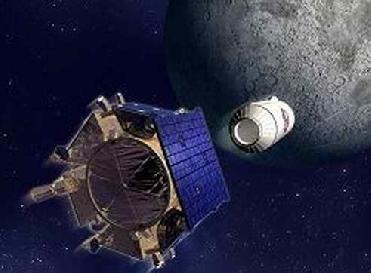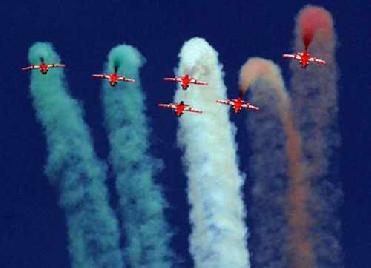
An artist's illustration shows the LCROSS mission shepherding a satellite releasing its SUV-sized rocket toward the moon. Credit: NASA
NEW YORK (BNS): Astronomers will look for water on the moon, when NASA fires a 2-tonne rocket into the polar crater later this year. Water is a crucial resource on the moon and it is not practical to transport to space the amount of water needed for human and exploration needs.
Using the powerful University of Arizona/Smithsonian MMT Observatory on Mount Hopkins, Arizona, astronomers will make the search. NASA selected a team of MMT Observatory and UA Steward Observatory astronomers as one of the four ground-based telescope teams to observe the moon on impact with its Lunar CRater Observation and Sensing Satellite mission, known as LCROSS, in August or later.
The LCROSS mission is a small companion mission to the Lunar Reconnaissance Orbiter, scheduled to be launched from Cape Canaveral in spring 2009. LCROSS will separate from the lunar orbiter soon after the launch.
Astronomers said that the piggybacking LCROSS mission consists of a shepherding spacecraft and a rocket weighing as much as a large SUV that will hit the moon at about 5,600 mph, excavating a crater about a third as wide as a football field and about as deep as the deep end of a swimming pool.
“Instruments aboard the shepherding spacecraft are designed to search for evidence of water ice on the moon as the rocket collides with a permanently shadowed crater near one of the moon's poles. Researchers predict that impact debris plumes reaching 30 miles high will be visible from the Earth with telescopes as small as 10 to 12 inches in diameter,” they said.
“At more than 20 times larger, the 6.5-meter (21-foot) MMTO telescope is well-suited to addressing the first LCROSS mission science goal: Confirm the presence or absence of water ice in a permanently shadowed region on the moon,” MMTO director and project team leader Faith Vilas said.
Vilas and co-investigators Donald McCarthy Jr., of the UA Steward Observatory, MMTO staff astronomer Morag Hastie, and MMTO principal engineer Shawn Callahan will use state-of-the-art instruments to observe the expanding debris plume concurrently at three different wavelengths.
They'll use an infrared camera and an infrared spectrograph in the "ARIES," an instrument that McCarthy developed, to take images and spectra to follow the shape and growth of the developing plume as well as probe for the presence of "phyllosilicates," or clays formed by the interaction of water with rocks.
“If we get the signature for phyllosilicates, then we've got a pretty firm indication that there's been water there,” Vilas said.
“ARIES also has a second detector that will take images of the plume at slightly shorter infrared wavelengths. And the team will use a beam splitter so they can also use a third camera to image the expanding plume in visible light,” she said.
“The cameras will take images at 1/100th of a second, so we'll see the plume as it builds and expands through time at high resolution,” Vilas said. Debris plume size and shape is governed by water vapour in the ejecta, she said.
“If NASA launches the Lunar Reconnaissance Orbiter in spring as scheduled, the LCROSS spacecraft will be fired in August to hit the moon's North Pole,” Vilas said.
August is southern Arizona's monsoon season, so there's some risk of being clouded out.
If launch is delayed, then the LCROSS spacecraft will be fired later to hit the moon's South Pole in September or October, she said.
 Next Article
Next Article













The Indian Air Force, in its flight trials evaluation report submitted before the Defence Ministry l..
view articleAn insight into the Medium Multi-Role Combat Aircraft competition...
view articleSky enthusiasts can now spot the International Space Station (ISS) commanded by Indian-American astr..
view article